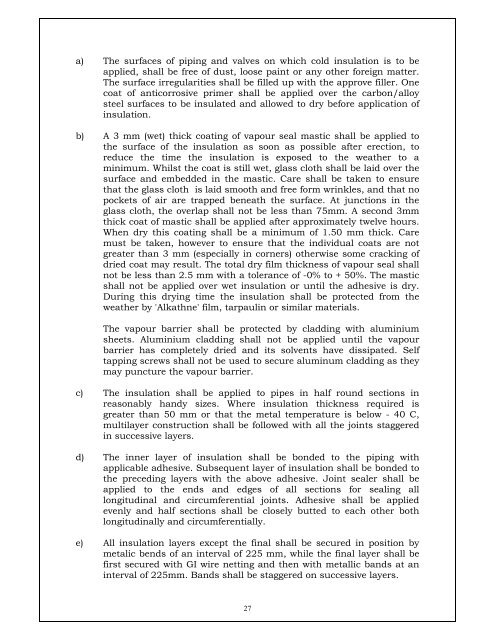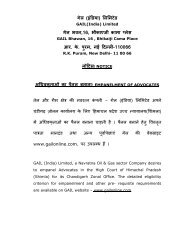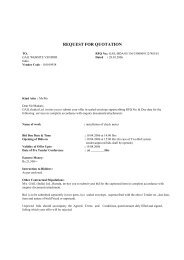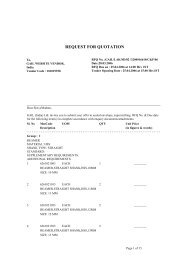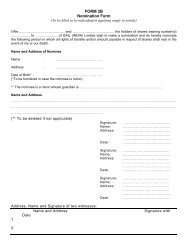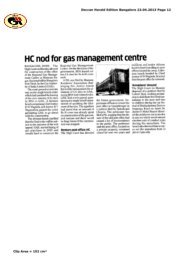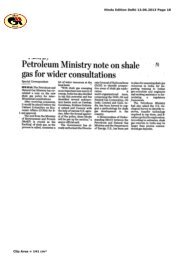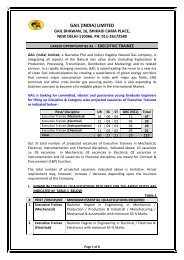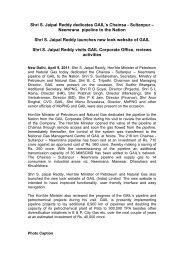invitation for bids - Gail
invitation for bids - Gail
invitation for bids - Gail
You also want an ePaper? Increase the reach of your titles
YUMPU automatically turns print PDFs into web optimized ePapers that Google loves.
a) The surfaces of piping and valves on which cold insulation is to beapplied, shall be free of dust, loose paint or any other <strong>for</strong>eign matter.The surface irregularities shall be filled up with the approve filler. Onecoat of anticorrosive primer shall be applied over the carbon/alloysteel surfaces to be insulated and allowed to dry be<strong>for</strong>e application ofinsulation.b) A 3 mm (wet) thick coating of vapour seal mastic shall be applied tothe surface of the insulation as soon as possible after erection, toreduce the time the insulation is exposed to the weather to aminimum. Whilst the coat is still wet, glass cloth shall be laid over thesurface and embedded in the mastic. Care shall be taken to ensurethat the glass cloth is laid smooth and free <strong>for</strong>m wrinkles, and that nopockets of air are trapped beneath the surface. At junctions in theglass cloth, the overlap shall not be less than 75mm. A second 3mmthick coat of mastic shall be applied after approximately twelve hours.When dry this coating shall be a minimum of 1.50 mm thick. Caremust be taken, however to ensure that the individual coats are notgreater than 3 mm (especially in corners) otherwise some cracking ofdried coat may result. The total dry film thickness of vapour seal shallnot be less than 2.5 mm with a tolerance of -0% to + 50%. The masticshall not be applied over wet insulation or until the adhesive is dry.During this drying time the insulation shall be protected from theweather by 'Alkathne' film, tarpaulin or similar materials.The vapour barrier shall be protected by cladding with aluminiumsheets. Aluminium cladding shall not be applied until the vapourbarrier has completely dried and its solvents have dissipated. Selftapping screws shall not be used to secure aluminum cladding as theymay puncture the vapour barrier.c) The insulation shall be applied to pipes in half round sections inreasonably handy sizes. Where insulation thickness required isgreater than 50 mm or that the metal temperature is below - 40 C,multilayer construction shall be followed with all the joints staggeredin successive layers.d) The inner layer of insulation shall be bonded to the piping withapplicable adhesive. Subsequent layer of insulation shall be bonded tothe preceding layers with the above adhesive. Joint sealer shall beapplied to the ends and edges of all sections <strong>for</strong> sealing alllongitudinal and circumferential joints. Adhesive shall be appliedevenly and half sections shall be closely butted to each other bothlongitudinally and circumferentially.e) All insulation layers except the final shall be secured in position bymetalic bends of an interval of 225 mm, while the final layer shall befirst secured with GI wire netting and then with metallic bands at aninterval of 225mm. Bands shall be staggered on successive layers.27


